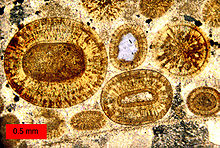This article needs additional citations for verification. (August 2014) |

A brief, easy-to-understand description of cementation is that minerals bond grains of sediment together by growing around them. This process is called cementation and is a part of the rock cycle.
Cementation involves ions carried in groundwater chemically precipitating to form new crystalline material between sedimentary grains. The new pore-filling minerals form "bridges" between original sediment grains, thereby binding them together. In this way, sand becomes sandstone, and gravel becomes conglomerate or breccia. Cementation occurs as part of the diagenesis or lithification of sediments. Cementation occurs primarily below the water table regardless of sedimentary grain sizes present. Large volumes of pore water must pass through sediment pores for new mineral cements to crystallize and so millions of years are generally required to complete the cementation process. Common mineral cements include calcite, quartz, and silica phases like cristobalite, iron oxides, and clay minerals; other mineral cements also occur.
Cementation is continuous in the groundwater zone, so much so that the term "zone of cementation" is sometimes used interchangeably. Cementation occurs in fissures or other openings of existing rocks and is a dynamic process more or less in equilibrium with a dissolution or dissolving process.
Cement found on the sea floor is commonly aragonite and can take different textural forms. These textural forms include pendant cement, meniscus cement, isopachous cement, needle cement, botryoidal cement, blocky cement, syntaxial rim cement, and coarse mosaic cement. The environment in which each of the cements is found depends on the pore space available. Cements that are found in phreatic zones include: isopachous, blocky, and syntaxial rim cements. As for calcite cementation, which occurs in meteoric realms (freshwater sources), the cement is produced by the dissolution of less stable aragonite and high-Mg calcite. (Boggs, 2011)
Classifying rocks while using the Folk classification depends on the matrix, which is either sparry (prominently composed of cement) or micritic (prominently composed of mud).